Macroscopic Evaluation of Poly(3-hydroxybutyrate-co-3-hydroxy valerate), PHBV-Based Nanofiber Scaffolds with Aloe Vera or Honey in Murine Wound Healing
Abstract
1. Introduction
2. Materials and Methods
2.1. Animals
2.2. Surgical Procedure
2.3. Scaffold Fabrication and Morphological Characterization
2.4. Control and Experimental Treatments
2.5. Histological Analysis
2.6. Statistical Analysis
3. Results
3.1. Animals
3.2. Scaffold Fabrication and Morphological Characterization
3.3. Histology
3.4. Statistical Analysis
4. Discussion
4.1. Antimicrobial Considerations in Wound Healing
4.2. Clinical Perspective and Translational Outlook
4.3. Limitations
5. Conclusions
Future Perspectives
6. Patents
Supplementary Materials
Author Contributions
Funding
Institutional Review Board Statement
Informed Consent Statement
Data Availability Statement
Acknowledgments
Conflicts of Interest
Abbreviations
| PHVB | Poly (3-hydroxybutyrate-co-3-hydroxy valerate) |
| PHBV/AV | Poly (3-hydroxybutyrate-co-3-hydroxy valerate)/Aloe Vera |
| PHBV/Ho | Poly (3-hydroxybutyrate-co-3-hydroxy valerate)/Honey |
| PBS | Phosphate-Buffered Saline |
| ECM | Extracellular matrix |
| PVA | Polyvinyl alcohol |
| PCL | Polycaprolactone |
| ULPGC | Universidad de Las Palmas de Gran Canaria |
| FESEM | Field Emission Scanning Electron Microscope |
| UV | Ultraviolet |
| AIC | Akaike Information Criterion |
| SE | Standard Errors |
| SIMACE | Advanced Confocal and Electron Microscopy Research Facility |
References
- Hernández-Fuentes, A.; Cháves-Borges, D.; Cenobio-Galindo, A.; Zepeda-Velázquez, A.; Figuera, A.; Jiménez-Alvarado, R.; Campos-Montiel, R. Characterization of total phenol and flavonoids contents, color, functional properties form honey samples with different floral origins. Inter. J. Food Stud. 2021, 10, 346–358. Available online: https://www.iseki-food-ejournal.com/ojs/index.php/e-journal/article/view/893/321 (accessed on 21 April 2024). [CrossRef]
- Jull, A.B.; Cullum, N.; Dumville, J.C.; Westby, M.J.; Deshpande, S.; Walker, N. Honey as a topical wound treatment. Cochrane Database Syst. Rev. 2015, 2015, CD005083. [Google Scholar] [CrossRef] [PubMed]
- Merckoll, P.; Jonassen, T.; Vad, M.; Jeansson, S.; Melby, K. Bacteria, biofilm, and honey: A study of the effects of honey on ‘planktonic’ and biofilm-embedded chronic wound bacteria. Scand. J. Infect. Dis. 2009, 41, 341–347. [Google Scholar] [CrossRef] [PubMed]
- Miguel, M.; Antunes, M.; Faleiro, M. Honey as a complementary medicine. Integr. Med. Insights 2017, 12, 1178633717702869. [Google Scholar] [CrossRef]
- Pereira, F.; Bártolo, P. Traditional therapies for skin wound healing. Adv. Wound Care 2016, 5, 208–229. [Google Scholar] [CrossRef] [PubMed]
- Ruttermann, M.; Maier-Hasselmann, A.; Nink-Grebe, B.; Burckhardt, M. Local treatment of chronic wounds. Dtsch. Arztebl. Int. 2013, 110, 25–31. [Google Scholar] [CrossRef][Green Version]
- Lee, S.K. Cell growth-stimulating effect. In New Perspectives on Aloe; Park, Y.I., Lee, S.K., Eds.; Springer: Boston, MA, USA, 2006. [Google Scholar] [CrossRef]
- Kumar, R.; Singh, K.; Gupta, A.; Bishayee, A.; Pandey, A. Therapeutic potential of aloe vera-a miracle gift of nature. Phytomedicine 2019, 60, 152996. [Google Scholar] [CrossRef]
- Lusby, P.; Coombes, A.; Wilkinson, J. Honey: A potent agent for wound healing? J. Wound Ostomy Cont. Nurs. Soc. 2002, 29, 295–300. [Google Scholar] [CrossRef]
- Mikołajczak, N. Potential health benefits of Aloe vera. J. Educ. Health Sport 2018, 8, 1420–1435. [Google Scholar] [CrossRef]
- Molan, P.C. The evidence supporting the use of honey as a wound dressing. Int. J. Low. Extrem. Wounds 2006, 5, 40–54. [Google Scholar] [CrossRef]
- Song, J.J.; Salcido, R. Use of honey in wound care: An update. Adv. Skin. Wound Care 2010, 24, 40–44. [Google Scholar] [CrossRef] [PubMed]
- Ullah, K.; Naz, S.; Abudbos, A. Towards a better understanding of the therapeutic applications and corresponding mechanisms of action of honey. Environ. Sci. Pollut. Res. 2017, 24, 27755–27766. [Google Scholar] [CrossRef]
- Davidson, J.; Yu, F.; Opalenik, S. Splinting strategies to overcome confounding wound contraction in experimental animal models. Adv. Wound Care 2013, 2, 142–148. [Google Scholar] [CrossRef] [PubMed]
- Ren, L.; Zhou, B.; Chen, L. Silicone ring implantation in an excisional murine wound model. Wound 2012, 24, 36–42. [Google Scholar] [PubMed]
- Yang, X.; Fan, L.; Ma, L.; Wang, Y.; Lin, S.; Yu, F.; Pan, X.; Luo, G.; Zhang, D.; Wang, H. Green electrospun Manuka honey/silk fibroin fibrous matrices as a potential wound dressing. Mater. Des. 2017, 119, 76–84. [Google Scholar] [CrossRef]
- Hernández-Rodríguez, J.; Martín-Barrasa, J.; Aragón-Sánchez, J.; Monzón-Mayor, M.; Pérez-Galván, J.; Saavedra-Santana, P.; Romero-Alemán, M. The effect of honey, aloe vera, and hydrocolloid dressing on the healing process of murine excisional wounds. Int. J. Low. Extrem. Wounds 2023, 22, 15347346231214597. [Google Scholar] [CrossRef]
- Almasaudi, S. The antibacterial activities of honey. Saudi J. Biol. Sci. 2021, 28, 2188–2196. [Google Scholar] [CrossRef]
- Bucekova, M.; Buriova, M.; Pekarik, L.; Matjan, V.; Matjan, J. Phytochemicals mediated hydrogen peroxide production is crucial for high antibacterial activity of honeydew honey. Sci. Rep. 2018, 8, 9061. [Google Scholar] [CrossRef]
- González-Gascón, R.; Del Dedo-Torre, P. Actualización sobre el uso de miel en el tratamiento de úlceras y heridas. Caso Clínico Enferm. Glob. 2004, 4, 1–10. [Google Scholar]
- Manjunatha, D.; Chua, L. The anti-inflammatory and wound-healing properties of honey. Eur. Food Res. Technol. 2014, 239, 1003–1014. [Google Scholar] [CrossRef]
- Weston, R. The contribution of catalase and other natural products to the antibacterial activity of honey: A review. Food Chem. 2000, 71, 235–239. [Google Scholar] [CrossRef]
- Bucekova, M.; Jardekova, L.; Juricova, V.; Bugarova, V.; Di Marco, G.; Gismondi, A.; Leonardi, D.; Farkasovska, J.; Godocikova, J.; Laho, M.; et al. Antibacterial activity of different blossom honeys: New findings. Molecules 2019, 24, 1573. [Google Scholar] [CrossRef]
- Cianciosi, D.; Forbes-Hernández, T.Y.; Afrin, S.; Gasparrini, M.; Reboredo-Rodriguez, P.; Manna, P.P.; Zhang, J.; Bravo Lamas, L.; Martínez Flórez, S.; Agudo Toyos, P.; et al. Phenolic compounds in honey and their associated health benefits: A review. Molecules 2018, 23, 2322. [Google Scholar] [CrossRef]
- Combarros-Fuertes, P.; Fresno, J.; Estevinho, M.; Sousa-Pimenta, M.; Tornadijo, M.; Estevinho, L. Honey: Another alternative in the fight against antibiotic resistant bacteria? Antibiotics 2020, 9, 774. [Google Scholar] [CrossRef] [PubMed]
- Da Silva, P.; Gauche, C.; Gonzaga, L.; Costa, A.; Felt, R. Honey: Chemical composition, stability, and authenticity. Food Chem. 2016, 196, 309–323. [Google Scholar] [CrossRef] [PubMed]
- Brudzynski, K. A current perspective on hydrogen peroxide production in honey. A review. Food Chem. 2020, 332, 127229. [Google Scholar] [CrossRef]
- Kwakman, P.H.; Te Velde, A.A.; de Boer, L.; Vandenbroucke-Grauls, C.M.; Zaat, S.A. Two major medicinal honeys have different mechanisms of bactericidal activity. PLoS ONE 2011, 6, e17709. [Google Scholar] [CrossRef] [PubMed]
- Maddocks, S.; Jenkins, R. Honey: A sweet solution to the growing problem of antimicrobial resistance? Future Microbiol. 2013, 8, 1419–1429. [Google Scholar] [CrossRef]
- Masoura, M.; Gkatzionis, K. The antimicrobial mechanism of Greek thyme honeys against methicillin-resistant Staphylococcus aureus clinical isolates: A case study of comparison with manuka honey. Int. J. Food Sci. Technol. 2022, 57, 7076–7084. [Google Scholar] [CrossRef]
- Yaghoobi, R.; Kazerouni, A.; Kazerouni, O. Evidence for clinical use of honey in wound healing as an anti-bacterial, anti-inflammatory, anti-oxidant and anti-viral agent: A review. Jundishapur. J. Nat. Pharm. Prod. 2013, 8, 100–104. [Google Scholar] [CrossRef]
- Bonsignore, G.; Martinotti, S.; Ranzato, E. Honey Bioactive Molecules: There Is a World Beyond the Sugars. BioTech 2024, 13, 47. [Google Scholar] [CrossRef] [PubMed] [PubMed Central]
- Cosmetic Ingredient Review Expert Panel. Final report on the safety assessment of AloeAndongensis Extract, Aloe Andongensis Leaf Juice, Aloe arborescens Leaf Extract, Aloe Arborescens Leaf Juice, Aloe Arborescens Leaf Protoplasts, Aloe Barbadensis Flower Extract, Aloe Barbadensis Leaf, Aloe Barbadensis Leaf Extract, Aloe Barbadensis Leaf Juice, aloe Barbadensis Leaf Polysaccharides, Aloe Barbadensis Leaf Water, Aloe Ferox Leaf Extract, Aloe Ferox Leaf Juice, and Aloe Ferox Leaf Juice Extract. Int. J. Toxicol. 2007, 26 (Suppl. S2), 1–50. [Google Scholar] [CrossRef]
- Hernández-Martínez, F.J.; Jiménez-Díaz, J.F.; Rodríguez de Vera, B.; Quintana-Montesdeoca, M.P.; Chacón-Ferrera, R.; Estévez-García, M.L. Therapeutic use of Aloe Vera in pressure ulcers (PU). Rev. CENIC Cienc. Biológicas 2020, 41, 1–4. Available online: https://www.redalyc.org/articulo.oa?id=181220509066 (accessed on 21 April 2024).
- Kim, K.W. Angiogenic effect. In New Perspectives on Aloe; Park, Y.I., Lee, S.K., Eds.; Springer: Boston, MA, USA, 2006. [Google Scholar] [CrossRef]
- Farzadinia, P.; Jofreh, N.; Khatamsaz, S.; Movahed, A.; Akbarzadeh, S.; Mohammadi, M.; Bargahi, A. Anti-inflammatory and wound healing activities of aloe vera, honey, and milk ointment on second-degree burns in rats. Int. J. Low. Extrem. Wounds 2016, 15, 241–247. [Google Scholar] [CrossRef]
- Habeeb, F.; Satables, G.; Bradbury, F.; Nong, S.; Cameron, P.; Plevin, R.; Ferro, V. The inner gel component of aloe vera suppresses bacterial-induced pro-inflammatory cytokines from human immune cells. Methods 2007, 42, 388–393. [Google Scholar] [CrossRef]
- Takzaree, N.; Hadjiakhndi, A.; Hassanzadeh, G.; Reza, M.; Manyi, A.; Majidi, A. Transforming growth factor-β (TFG-β) activation in cutaneous wounds after topical application of aloe vera gel. Can. J. Physiol. Pharmacol. 2016, 94, 1285–1290. [Google Scholar] [CrossRef] [PubMed]
- Choi, S.; Son, B.; Son, Y.; Park, Y.; Lee, S.; Chung, M. The wound-healing effect of a glycoprotein fraction isolated from aloe vera. Br. J. Dermato. 2001, 145, 535–545. [Google Scholar] [CrossRef]
- Raza, Z.A.; Khalil, S.; Abid, S. Recent progress in development and chemical modification of poly(hydroxybutyrate)-based blends for potential medical applications. Int. J. Biol. Macromol. 2020, 160, 77–100. [Google Scholar] [CrossRef]
- Ibrahim, M.I.; Alsafadi, D.; Alamry, K.A.; Husseim, M. Properties and Applications of Poly(3-hydroxybutyrate-co-3-hydroxyvalerate) Biocomposites. J. Polym. Environ. 2021, 29, 1010–1030. [Google Scholar] [CrossRef]
- Das, R.; Pal, A.; Paul, A.K. Biosynthesis and accumulation of poly(3-hydroxybutyrate-co-3-hydroxyvalerate)-polyethylene glycol, a hybrid co-polymer by endophytic Bacillus cereus RCL 02. Bioprocess Biosyst. Eng. 2019, 42, 807–815. [Google Scholar] [CrossRef]
- Rodríguez-Cendal, A.I.; Gómez-Seoane, I.; de Toro-Santos, F.J.; Fuentes-Boquete, I.M.; Señarís-Rodríguez, J.; Díaz-Prado, S.M. Biomedical Applications of the Biopolymer Poly(3-hydroxybutyrateco-3-hydroxyvalerate) (PHBV): Drug Encapsulation and Scaffold Fabrication. Int. J. Mol. Sci. 2023, 24, 11674. [Google Scholar] [CrossRef] [PubMed]
- Chen, W.; Tong, Y. PHBV microspheres as neural tissue engineering scaffolds support neuronal cell growth and axon–dendrite polarization. Acta Biomater. 2012, 8, 540–548. [Google Scholar] [CrossRef] [PubMed]
- Romero-Alemán, M.M.; Hernández-Rodríguez, J.E.; Pérez-Galván, J.M.; Monzón-Mayor, M. Hybrid electrospun PHBV/Aloe vera and PHBV/Honey nanofibers are scaffolds for rat dorsal root ganglion neurite outgrowth and guidance as well as for the regeneration of mouse skin after wounding. Glia 2019, 67 (Suppl. S1), E654–E655. [Google Scholar]
- Romero-Alemán, M.D.; Pérez-Galván, J.M.; Hernández-Rodríguez, J.E.; Monzón-Mayor, M. The Potential of Aloe Vera in Solution and in Blended Nanofibers Containing Poly (3-Hydroxybutyrate-Co-3-Hydroxyvalerate) as Substrates for Neurite Outgrowth. J. Biomed. Mater. Res. 2025, 113, e37825. [Google Scholar] [CrossRef] [PubMed]
- Satalkar, P.; Elger, B.; Shaw, D. Defining nano, nanotechnology, and nanomedicine: Why should it matter? Sci. Eng. Ethics 2016, 22, 255–1276. [Google Scholar] [CrossRef]
- Prabhakaran, M.; Vatankhah, E.; Ramakrishna, S. Electrospun aligned PHBV/collagen nanofibers as substrates for nerve tissue engineering. Biotechnol. Bioeng. 2013, 110, 2775–2784. [Google Scholar] [CrossRef]
- Dumontel, B.; Conejo-Rodríguez, V.; Vallet-Regí, M.; Manzano, M. Natural Biopolymers as Smart Coating Materials of Mesoporous Silica Nanoparticles for Drug Delivery. Pharmaceutics 2023, 15, 447. [Google Scholar] [CrossRef]
- Jaldin-Crespo, L.; Silva, N.; Martínez, J. Nanomaterials based on honey and propolis for wound healing—A mini-review. Nanomaterials 2022, 12, 4409. [Google Scholar] [CrossRef]
- Lee, I.; Kwon, H.; Meng, W.; Kang, K. Nanofabrication of microbial polyester by electrospinning promotes cell attachment. Macromol. Res. 2004, 12, 374–378. [Google Scholar] [CrossRef]
- Chen, C.Q.; Wu, Q. The application of polyhydroxyalkanoates as tissue engineering materials. Biomaterials 2005, 26, 6565–6578. [Google Scholar] [CrossRef]
- Asl, M.A.; Karbasi, S.; Beigi-Boroujeni, S.; Zamanlui Benisi, S.; Saeed, M. Evaluation of the effects of starch on polyhydroxybutyrate electrospun scaffolds for bone tissue engineering applications. Int. J. Biol. Macromol. 2021, 191, 500–513. [Google Scholar] [CrossRef] [PubMed]
- Rahman, S.; Carter, P.; Bhattarai, N. Aloe vera for tissue engineering applications. J. Funct. Biomater. 2017, 8, 6. [Google Scholar] [CrossRef]
- Thompson, Z.; Rahman, S.; Yarmolenko, S.; Sankar, J.; Kumar, D.; Bhattarai, N. Fabrication and characterization of magnesium ferrite-based PCL/Aloe vera nanofibers. Materials 2017, 10, 937. [Google Scholar] [CrossRef] [PubMed]
- Masaeli, E.; Morshed, M.; Nasr-Esfahani, M.H.; Sadri, S.; Hilderink, J.; van Apeldoorn, A.; van Blitterswijk, C.A.; Moroni, L. Fabrication, characterization, and cellular compatibility of poly(hydroxy alkanoate) composite nanofibrous scaffolds for nerve tissue engineering. PLoS ONE 2013, 8, e57157. [Google Scholar] [CrossRef] [PubMed]
- Rubiano-Navarrete, A.F.; Rosas, C.R.A.; Torres, P.Y.; Gómez-Pachón, E.Y. From fibers electrospun with honey to the healing of wounds: A review. Ing. Y Compet. 2024, 26, e-30112811. [Google Scholar] [CrossRef]
- Shishatskaya, E.; Volova, T.; Puzyr, A.; Mogilnaya, O.; Efremov, S. Tissue response to the implantation of biodegradable polyhydroxyalkanoate sutures. J Mat. Sci. Mater. Med. 2004, 15, 719–728. [Google Scholar] [CrossRef]
- Yupanqui, M.; Vyas, C.; Aslan, E.; Humphreys, G.; Diver, C.; Bartolo, P. Honey: An advanced antimicrobial and wound healing biomaterial for tissue engineering applications. Pharmaceutics 2022, 10, 1663. [Google Scholar] [CrossRef]
- Monzón-Monzón, M.; Romero-Alemán, M.M.; Hernández-Rodríguez, J.E.; Pérez-Galván, J.M. Hybrid Aloe Vera Nano-Fibers. EP3461788, 12 October 2022. [Google Scholar]
- Monzón-Monzón, M.; Romero-Alemán, M.M.; Hernández-Rodríguez, J.E.; Pérez-Galván, J.M. Hybrid Honey Nano-Fibers. EP3428117, 27 July 2022. [Google Scholar]
- Russell, W.M.S. The Three Rs: Past, present and future. Anim. Welf. 2005, 14, 279–286. [Google Scholar] [CrossRef]
- European Parliament and Council of the European Union. Directive 2010/63/EU on the protection of animals used for scientific purposes. Off. J. Eur. Union. 2010, L276, 33–79. [Google Scholar]
- Ansell, D.; Campbell, L.; Thomason, H.; Brass, A.; Hardman, M. A statistical analysis of murine incisional and excisional acute wound models. Wound Rep. Reg. 2014, 22, 281–287. [Google Scholar] [CrossRef]
- Mukai, K.; Koike, M.; Nakamura, S.; Kawaguchi, Y.; Katagiri, F.; Nojiri, S.; Yamada, Y.; Miyajima, E.; Matsumoto, M.; Komatsu, E.; et al. Evaluation of the effects of a combination of Japanese honey and hydrocolloid dressing on cutaneous wound healing in male mice. Evid. Based Complement. Altern. Med. 2015, 2015, 910605. [Google Scholar] [CrossRef] [PubMed]
- Martins, S.; Torres, O.; Santos, O.; Limeira-Júnior, A.; Sauaia-Filho, E.; Melo, S.; Santos, R.; Silva, V. Analysis of the healing process of the wounds occurring in rats using laser therapy associated with hydrocolloid. Acta Cirúrgica Bras. 2015, 30, 681–685. [Google Scholar] [CrossRef]
- Takeuchi, T.; Ito, M.; Yamaguchi, S.; Watanabe, S.; Honda, M.; Imahashi, T.; Yamada, T.; Kokubo, T. Hydrocolloid dressing improves wound healing by increasing M2 macrophage polarization in diabetic mice. Nagoya J. Med. Sci. 2020, 82, 487–498. [Google Scholar] [CrossRef]
- Rasband, W.S. ImageJ, 2.16.0/1.54p; U.S. National Institutes of Health: Bethesda, MD, USA, 1997–2018. Available online: https://imagej.nih.gov/ij/ (accessed on 17 April 2024).
- Molina, A.; Moyano, M.; Peña, F.; Lora, A.; Moreno, S.; Serrano, J. Central Nervous System depressants and anaesthesia in experimental rodents. Recvet 2008, 3, 1–17. Available online: https://www.researchgate.net/publication/353849333_Depresores_del_Sistema_Nervioso_Central_y_anestesia_en_roedores_de_experimentacion_Central_Nervous_System_depressant_and_anaesthesia_of_Laboratory_rodents (accessed on 2 November 2014).
- Scepankova, H.; Combarros-Fuertes, P.; Fresno, J.M.; Tornadijo, M.E.; Dias, M.S.; Pinto, C.A.; Saraiva, J.A.; Estevinho, L.M. Role of honey in advanced wound care. Molecules 2021, 26, 4784. [Google Scholar] [CrossRef]
- Giusto, G.; Vercelli, C.; Comino, F.; Caramello, V.; Tursi, M.; Gandini, M. A new, easy-to-make pectin-honey hydrogel enhances wound healing in rats. BMC Complement. Altern. Med. 2017, 17, 266. [Google Scholar] [CrossRef]
- Yixiang, D.; Yong, T.; Liao, S.; Chan, C.K.; Ramakrishna, S. Degradation of electrospun nanofiber scaffold by short wave length ultraviolet radiation treatment and its potential applications in tissue engineering. Tissue Eng. Part A 2008, 14, 1321–1329. [Google Scholar] [CrossRef] [PubMed]
- Schindelin, J.; Arganda-Carreras, I.; Frise, E.; Kaynig, V.; Longair, M.; Pietzsch, T.; Preibisch, S.; Rueden, C.; Saalfeld, S.; Schmid, B.; et al. Fiji: An open-source platform for bio-logical-image analysis. Nat. Methods 2012, 9, 676–682. [Google Scholar] [CrossRef] [PubMed]
- Laird, N.M.; Ware, J.H. Random-effects models for longitudinal data. Biometrics 1982, 38, 963–974. [Google Scholar] [CrossRef] [PubMed]
- Cavanaugh, J.; Neath, A. The Akaike information criterion: Background, derivation, properties, application, interpretation, and refinements. Wiley Interdiscip. Rev. Comput. Stat. 2019, 11, e1460. [Google Scholar] [CrossRef]
- R Development Core Team. R: A Language and Environment for Statistical Computing (Version 3.6.1); R Foundation for Statistical Computing: Vienna, Austria, 2019; Available online: https://www.R-project.org/ (accessed on 19 July 2019).
- Andreu, V.; Mendoza, G.; Arruebo, M.; Irusta, S. Smart dressings based on nanostructured fibers containing natural origin antimicrobial, anti-Inflammatory, and regenerative compounds. Materials 2015, 8, 5154–5193. [Google Scholar] [CrossRef] [PubMed]
- Maleki, H.; Gharehaghaji, A.; Dijkstra, P. A novel honey-based nanofibrous scaffold for wound dressing application. J. Appl. Polym. Sci. 2013, 127, 4086–4092. [Google Scholar] [CrossRef]
- Abrigo, M.; McArthur, S.L.; Kingshott, P. Electrospun nanofibers as dressings for chronic wound care: Advances, challenges, and prospects. Macromol. Biosci. 2014, 14, 772–792. [Google Scholar] [CrossRef]
- Alven, S.; Khwaza, V.; Oyedeji, O.O.; Aderibigbe, B.A. Polymer-Based Scaffolds Loaded with Aloe vera Extract for the Treat-ment of Wounds. Pharmaceutics 2021, 13, 961. [Google Scholar] [CrossRef] [PubMed] [PubMed Central]
- Sosiati, H.; Nur Fatihah, W.; Yusmaniar, Y.; Nur Rahman, M.B. Characterization of the Properties of Electrospun Blended Hybrid Poly(Vinyl Alcohol)_Aloe Vera/Chitosan Nano-Emulsion Nanofibrous Membranes. Key Eng. Mater. 2018, 792, 74–79. [Google Scholar] [CrossRef]
- Sarkar, S.; Chaudhary, A.; Kumar, S.T.; Kumar, D.A.; Chatterjee, J. Modulation of collagen population under honey-assisted wound healing in a diabetic rat model. Wound Med. 2018, 20, 7–17. [Google Scholar] [CrossRef]
- Pilehvar-Soltanahmadi, Y.; Dadashpour, M.; Mohajeri, A.; Fattahi, A.; Sheervalilou, R.; Zarghami, N. An overview on application of natural substances incorporated with electrospun nanofibrous scaffolds to development of innovative wound dressings. Mini Rev. Med. Chem. 2018, 18, 414–427. [Google Scholar] [CrossRef] [PubMed]
- Rossiter, K.; Cooper, A.J.; Voegeli, D.; Lwaleed, B.A. Honey promotes angiogenic activity in the rat aortic ring assay. J. Wound Care 2010, 19, 440–446. [Google Scholar] [CrossRef]
- Gavillero-Martin, A.; Juliá-Roca, M.; Serra-Guillén, I.; Rodríguez-Hernández, A.; Manrique-Silva, E.; López-Sundh, A.E.; Nagore, E. Secondary Intention healing time of postoperative surgical cancer skin wounds with a biosynthetic porcine type I collagen dressing: A 306-patient retrospective, observational study. Actas Dermo-Sifiliográficas, 2024; in press. [Google Scholar] [CrossRef]
- Molina, G.E.; Sherry, Y.H.; Neel, V.A. Observations Regarding Infection Risk in Lower-Extremity Wound Healing by Second Intention. Dermatol. Surg. 2020, 46, 1342–1344. [Google Scholar] [CrossRef]
- Rodrigues, M.; Kosaric, N.; Bonham, C.A.; Gurtner, G.C. Wound Healing: A Cellular Perspective. Physiol. Rev. 2019, 99, 665–706. [Google Scholar] [CrossRef]
- Van Zutphen, L.; Baumans, V.; Beynen, A. Principles of Laboratory Animal Science, 2nd ed.; Elsevier Science: Amsterdam, The Netherlands, 2001; Available online: https://www.humane-endpoints.info/es/rata/parametros-fisiologicos (accessed on 24 August 2017).
- Suwantong, O.; Waleetorncheepsawat, S.; Sanchavanakit, N.; Pavasant, P.; Cheepsunthorn, P.; Bunaprasert, T.; Supaphol, P. In vitro biocompatibility of electrospun poly(3-hydroxybutyrate) and poly(3-hydroxybutyrate-co-3-hydroxyvalerate) fiber mats. Int. J. Biol. Macromol. 2007, 40, 217–223. [Google Scholar] [CrossRef] [PubMed]
- Rahimnejad, M.; Derakhshanfar, S.; Zhong, W. Biomaterials and tissue engineering for scar management in wound care. Burns Trauma 2017, 5, 4. [Google Scholar] [CrossRef] [PubMed]
- European Medicines Agency. Good Manufacturing Practice; EMA: Amsterdam, The Netherlands, 2025; Available online: https://www.ema.europa.eu/en/human-regulatory-overview/research-development/compliance-research-development/good-manufacturing-practice (accessed on 13 June 2025).
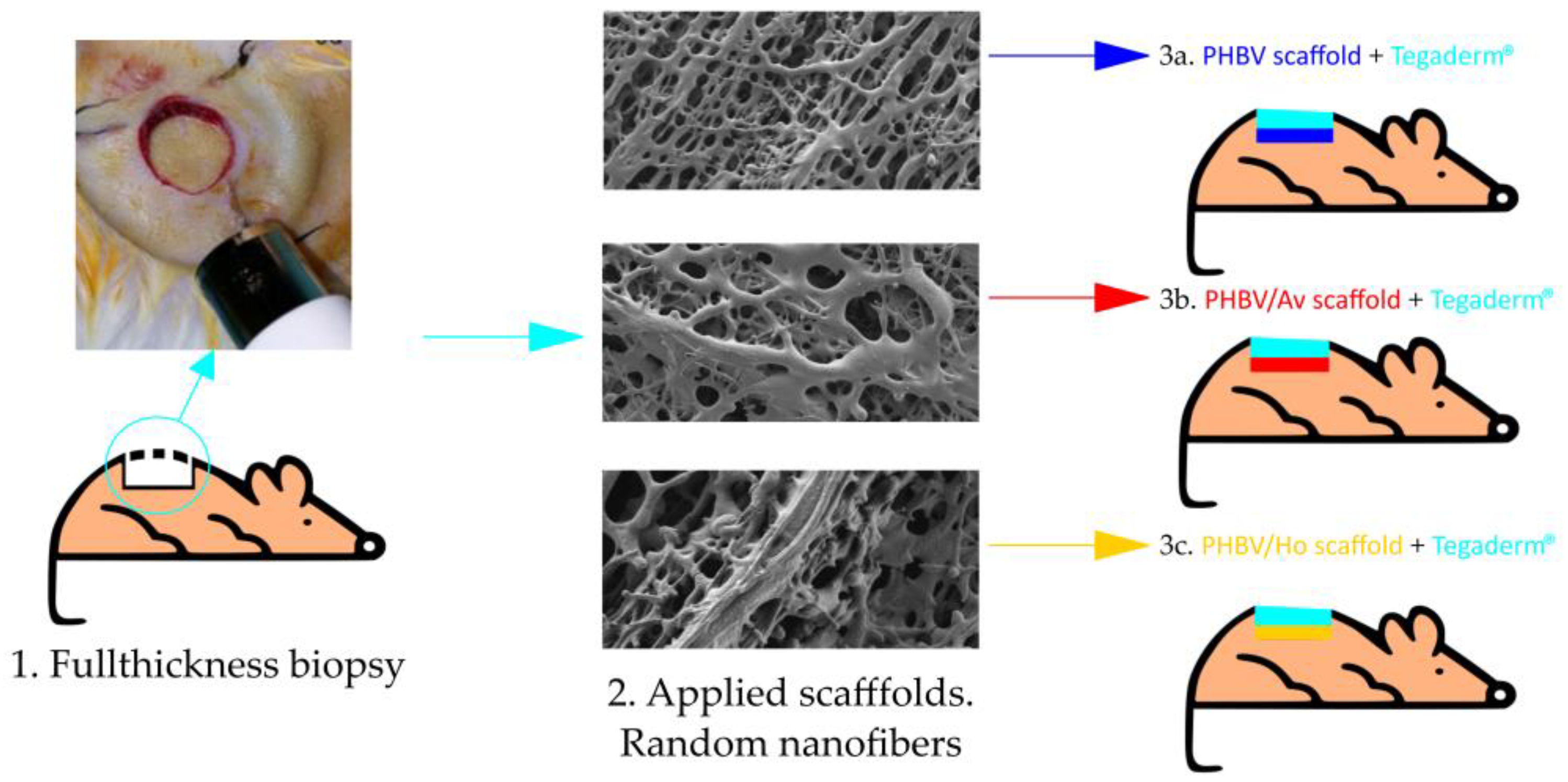
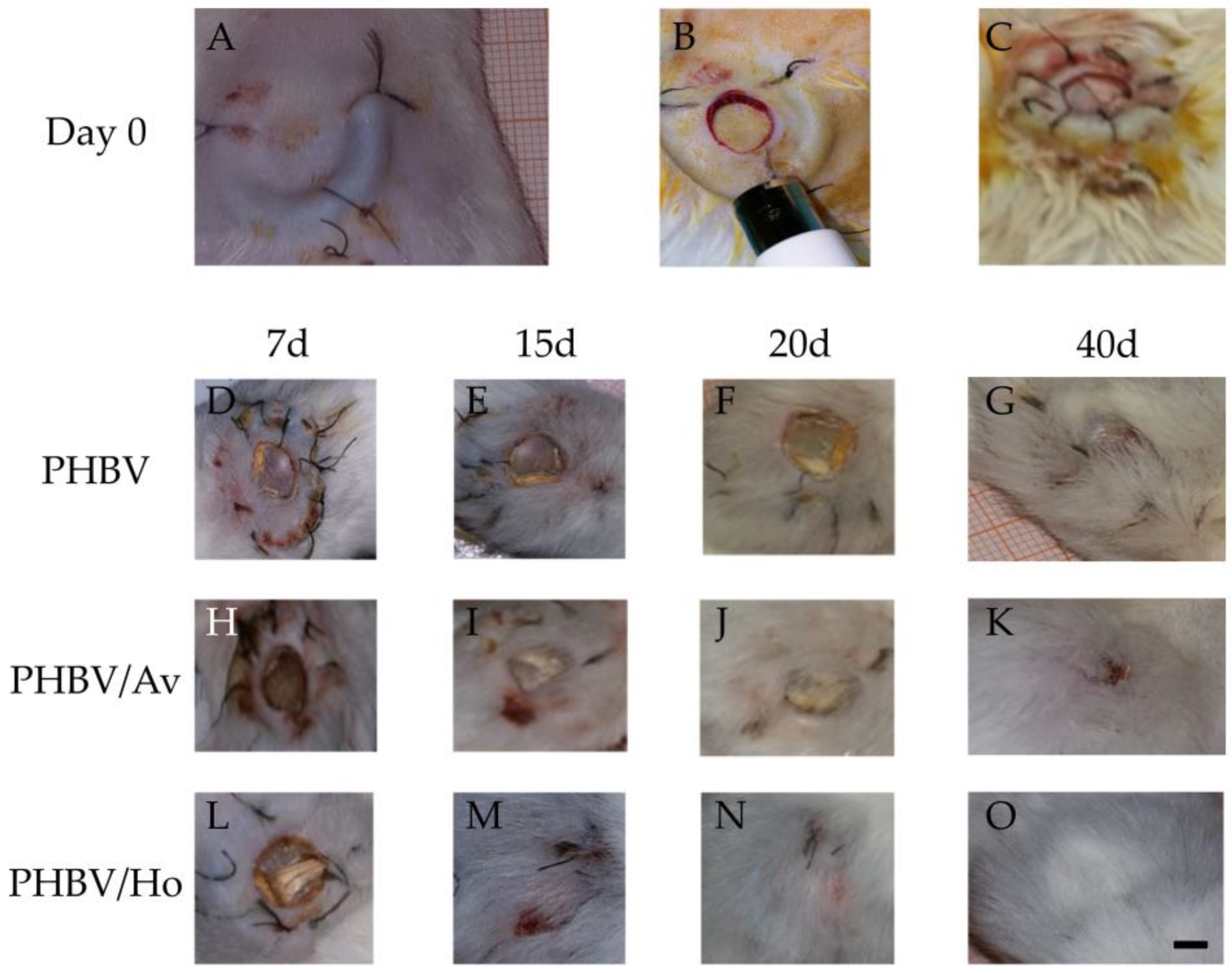
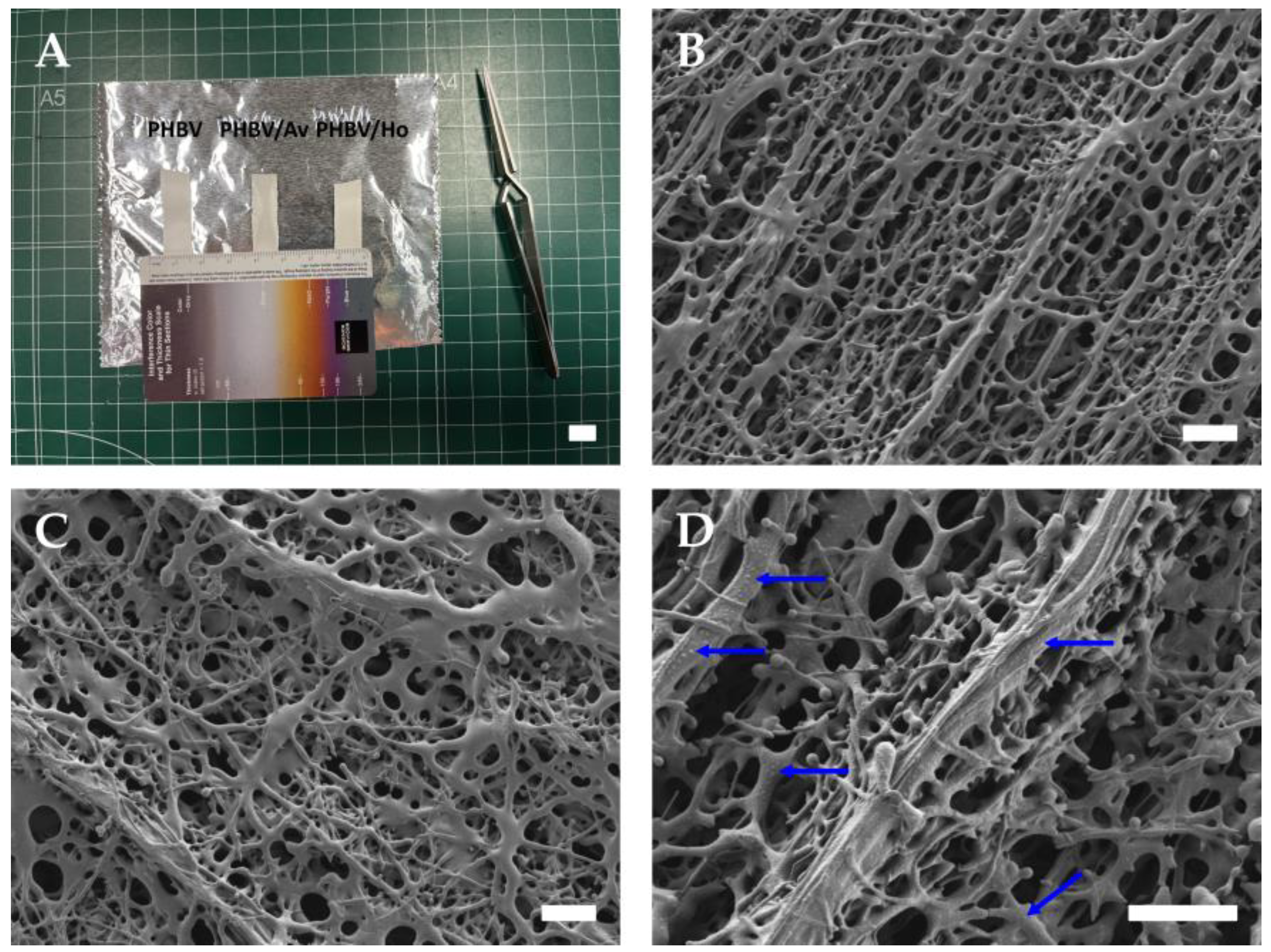
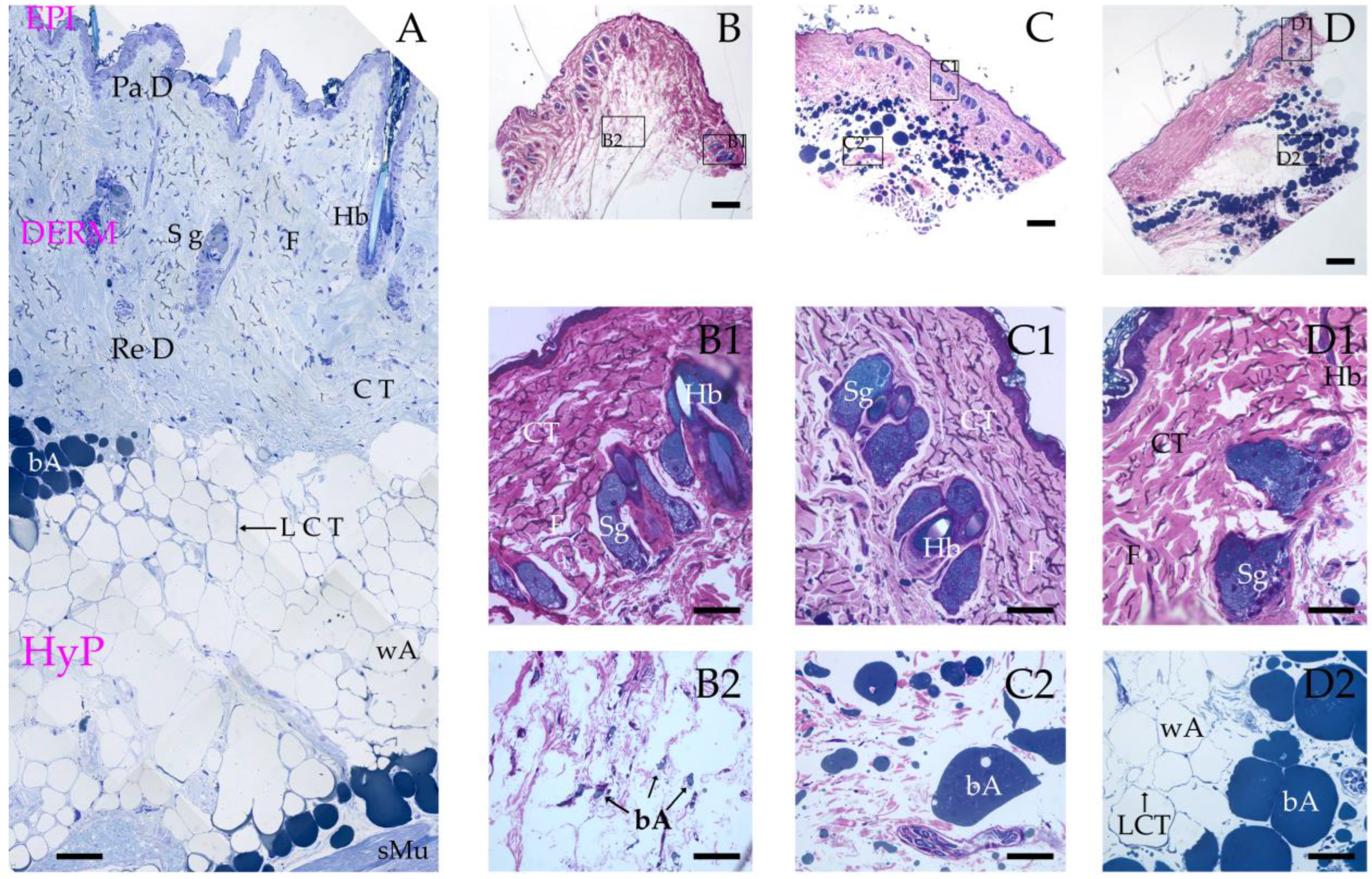
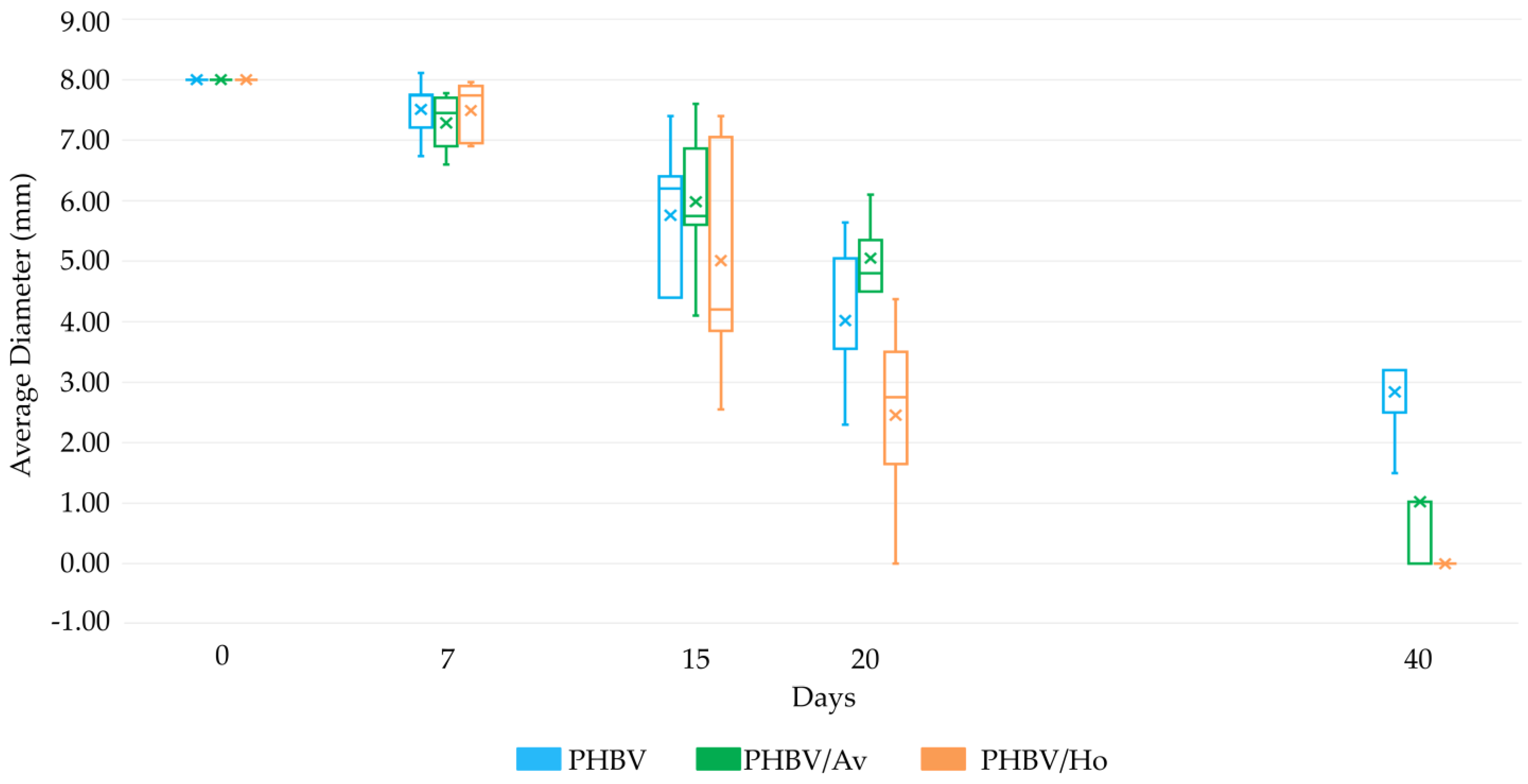
| Main Components | ||
|---|---|---|
| Honey | Aloe Vera | PHBV |
| A complex natural substance composed mainly of: | A complex natural substance composed mainly of: | It is a random copolymer of 3HB and 3HV |
| Sugar (fructose 38%; glucose 31%) | Polysaccharides (e.g., acemannan) | monomer units: |
| Water (17%) | Glycoproteins | 3-hydroxybutyrate; CH3-CH(OH)-CH2-COO− |
| Organics acids (e.g., gluconic acid) | 3-hydroxyvalerate; CH3-CH2-CH(OH)CH2-COO− | |
| Enzymes (e.g., glucose oxidase, catalase) | ||
| Phenolic compounds and flavonoids | ||
| Vitamins and minerals | ||
| Defensin 1 peptide |
| Treatment (No.) | Day 0 (First) | Day 40 (Last) | Percent Reduction |
|---|---|---|---|
| PHBV | 8 (8, 8) | 2.5 (2.5, 3.2) | 68.8 (60, 68.8) a |
| PHBV + Honey | 8 (8, 8) | 0 (0, 0) | 100 (100, 100) b |
| PHBV + Aloe Vera | 8 (8, 8) | 0 (0, 1) | 100 (87.2, 100) a,b |
| Coefficient (SE) | p-Value | |
|---|---|---|
| (Intercept) Treatment | 2.334 (0.085) | <0.001 |
| PHBV (reference) | 0 | - |
| PHBV + Honey | −0.382 (0.107) | <0.001 |
| PHBV + Aloe Vera | −0.136 (0.109) | 0.211 |
| Time, per day | −0.054 (0.004) | <0.001 |
Disclaimer/Publisher’s Note: The statements, opinions and data contained in all publications are solely those of the individual author(s) and contributor(s) and not of MDPI and/or the editor(s). MDPI and/or the editor(s) disclaim responsibility for any injury to people or property resulting from any ideas, methods, instructions or products referred to in the content. |
© 2025 by the authors. Licensee MDPI, Basel, Switzerland. This article is an open access article distributed under the terms and conditions of the Creative Commons Attribution (CC BY) license (https://creativecommons.org/licenses/by/4.0/).
Share and Cite
Pérez-Galván, J.M.; Hernández-Rodríguez, J.E.; Martín-Barrasa, J.L.; Monzón-Mayor, M.; Saavedra-Santana, P.; Romero-Alemán, M.d.M. Macroscopic Evaluation of Poly(3-hydroxybutyrate-co-3-hydroxy valerate), PHBV-Based Nanofiber Scaffolds with Aloe Vera or Honey in Murine Wound Healing. Pharmaceutics 2025, 17, 833. https://doi.org/10.3390/pharmaceutics17070833
Pérez-Galván JM, Hernández-Rodríguez JE, Martín-Barrasa JL, Monzón-Mayor M, Saavedra-Santana P, Romero-Alemán MdM. Macroscopic Evaluation of Poly(3-hydroxybutyrate-co-3-hydroxy valerate), PHBV-Based Nanofiber Scaffolds with Aloe Vera or Honey in Murine Wound Healing. Pharmaceutics. 2025; 17(7):833. https://doi.org/10.3390/pharmaceutics17070833
Chicago/Turabian StylePérez-Galván, José Manuel, José Enrique Hernández-Rodríguez, José Luis Martín-Barrasa, Maximina Monzón-Mayor, Pedro Saavedra-Santana, and María del Mar Romero-Alemán. 2025. "Macroscopic Evaluation of Poly(3-hydroxybutyrate-co-3-hydroxy valerate), PHBV-Based Nanofiber Scaffolds with Aloe Vera or Honey in Murine Wound Healing" Pharmaceutics 17, no. 7: 833. https://doi.org/10.3390/pharmaceutics17070833
APA StylePérez-Galván, J. M., Hernández-Rodríguez, J. E., Martín-Barrasa, J. L., Monzón-Mayor, M., Saavedra-Santana, P., & Romero-Alemán, M. d. M. (2025). Macroscopic Evaluation of Poly(3-hydroxybutyrate-co-3-hydroxy valerate), PHBV-Based Nanofiber Scaffolds with Aloe Vera or Honey in Murine Wound Healing. Pharmaceutics, 17(7), 833. https://doi.org/10.3390/pharmaceutics17070833





